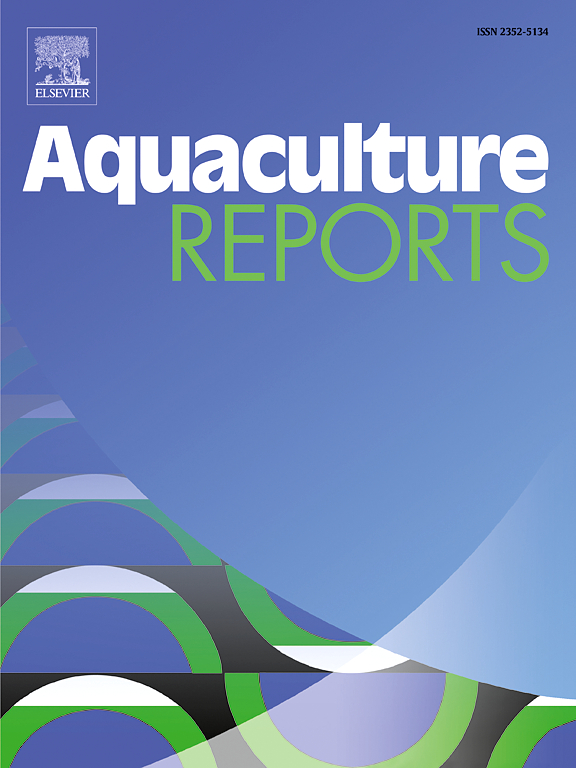IGF/MIP promotes shell growth through activation of Runt-related transcription factors in the pearl oyster Pinctada fucata martensii
IF 3.7
2区 农林科学
Q1 FISHERIES
引用次数: 0
Abstract
Biomineralization, the biologically controlled process of shell (exoskeleton) formation, is a critical indicator of growth in mollusks. In the pearl oyster Pinctada fucata martensii, the insulin-like growth factor (IGF) homolog MIP-1 and the Runt-related transcription factor PmRunt have been identified as key regulators of shell development. However, the phenotypic effects and regulatory mechanisms of these genes remain poorly understood. In this study, RNA interference (RNAi) was used to suppress PmRunt expression, resulting in significant reductions in shell length, height, width, and nacre thickness by 42.86 %, 42.86 %, 66.67 %, and 83.63 %, respectively, compared to that observed in the control. Similarly, pharmacological inhibition of PmRunt activation using RO5–3335 significantly decreased shell length, height, and width growth rates by 20 %, 33 %, and 66.67 %, respectively. Furthermore, overexpression of MIP-1 via recombinant protein injection significantly increased the transcriptional and post-translational activation of PmRunt, whereas RNAi-mediated knockdown of MIP-1 had the opposite effect (P < 0.05). Western blot analysis confirmed that MIP-1 overexpression significantly increased the expression and phosphorylation levels of PmRunt protein compared to that in the control, while MIP-1 knockdown significantly reduced these levels (P < 0.05). Dual-luciferase assays revealed that MIP-1 overexpression significantly enhanced the promoter activity of the PmRunt gene (P < 0.05). Together, these findings reveal that MIP-1 facilitates shell growth and nacre deposition in P. f. martensii by upregulating and activating PmRunt through transcriptional and phosphorylation-mediated mechanisms. This study highlights the pivotal role of the MIP-1/PmRunt axis signaling in regulating biomineralization, providing valuable insights into genetic strategies for enhancing pearl oyster shell formation and pearl quality.
IGF/MIP通过激活runt相关转录因子促进马氏珠贝壳生长
生物矿化是软体动物外壳(外骨骼)形成的生物控制过程,是软体动物生长的重要指标。在珍珠牡蛎中,胰岛素样生长因子(IGF)同源物MIP-1和runt相关转录因子PmRunt已被确定为贝壳发育的关键调控因子。然而,这些基因的表型效应和调控机制仍然知之甚少。在本研究中,使用RNA干扰(RNAi)抑制PmRunt的表达,导致壳长、高度、宽度和珍珠层厚度分别比对照组显著减少42.86 %、42.86 %、66.67 %和83.63 %。同样,使用RO5-3335对PmRunt激活的药理抑制显著降低了壳长、高和宽的生长速率,分别降低了20 %、33 %和66.67 %。此外,通过重组蛋白注射过表达MIP-1可显著增加PmRunt的转录和翻译后激活,而rnai介导的MIP-1敲低则具有相反的作用(P <; 0.05)。Western blot分析证实,与对照组相比,MIP-1过表达显著增加PmRunt蛋白的表达和磷酸化水平,而MIP-1敲低显著降低PmRunt蛋白的表达和磷酸化水平(P <; 0.05)。双荧光素酶检测显示,MIP-1过表达显著增强了PmRunt基因启动子活性(P <; 0.05)。在一起,这些发现表明,MIP-1促进壳增长和珍珠层沉积在p . f . martensii移植并通过转录激活PmRunt和phosphorylation-mediated机制。本研究强调了MIP-1/PmRunt轴信号在生物矿化调控中的关键作用,为提高珍珠牡蛎壳形成和珍珠品质的遗传策略提供了有价值的见解。
本文章由计算机程序翻译,如有差异,请以英文原文为准。
求助全文
约1分钟内获得全文
求助全文
来源期刊

Aquaculture Reports
Agricultural and Biological Sciences-Animal Science and Zoology
CiteScore
5.90
自引率
8.10%
发文量
469
审稿时长
77 days
期刊介绍:
Aquaculture Reports will publish original research papers and reviews documenting outstanding science with a regional context and focus, answering the need for high quality information on novel species, systems and regions in emerging areas of aquaculture research and development, such as integrated multi-trophic aquaculture, urban aquaculture, ornamental, unfed aquaculture, offshore aquaculture and others. Papers having industry research as priority and encompassing product development research or current industry practice are encouraged.
 求助内容:
求助内容: 应助结果提醒方式:
应助结果提醒方式:


